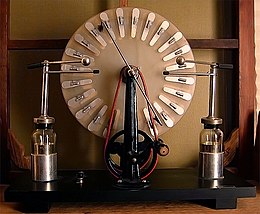Wimshurst machine
From Wikipedia, the free encyclopedia

Wimshurst machine with two Leyden jars.

Suppose that the conditions are as in the figure that is the segment A1 is positive and the segment B1 negative. Now, as A1 moves to the left and B1 to the right, their potentials will rise on account of the work done in separating them against attraction. When A1 comes opposite the segment B2 of the B plate, which is now in contact with the brush Y, it will be at a high positive potential, and will therefore cause a displacement of electricity along the conductor between Y and Y1 bringing a large negative charge on B1 and sending a positive charge to the segment touching. As A1 moves on, it passes near the brush Z and is partially discharged into the external circuit. It then passes on until, on touching the brush X it is put in connection with X, and has a new charge, this time negative, driven into it by induction from B2. Positive electricity, then, being carried by the conducting patches from right to left on the upper half of the A plate, and negative from left to right on its lower half.
|
The Wimshurst machine is an electrostatic device for generating high voltages developed between 1880 and 1883 by British inventor James Wimshurst (1832 – 1903). It has a distinctive appearance with two large contra-rotating discs mounted in a vertical plane, two cross bars with metallic brushes, and a spark gap formed by two metal spheres.
Contents |
[edit] Description
These machines belong to a class of generators called influence machines, which separate electric charges through electrostatic induction, or influence. Earlier machines in this class were developed by Wilhelm Holtz (1865 and 1867), August Toepler (1865), and J. Robert Voss (1880). The older machines were less efficient and exhibited an unpredictable tendency to switch their polarity. The Wimshurst did not have this defect.
In a Wimshurst machine, the two insulated disks and their metal sectors rotate in opposite directions passing the crossed metal neutralizer bars and their brushes. An imbalance of charges is induced, amplified, and collected by two pairs of metal combs with points placed near the surfaces of each disk. These collectors are mounted on insulating supports and connected to the output terminals. The positive feedback increases the accumulating charges exponentially until the dielectric breakdown voltage of the air is reached and a spark jumps across the gap.
The machine is self-starting, meaning that external electrical energy is not required to create the initial charge. However, it does require mechanical power to turn the disks against the electric field, and it is this energy that the machine converts into electric power. The output of the Wimshurst machine is essentially a constant current that is proportional to the area covered by the metal sectors and to the rotation speed. The insulation and the size of the machine determine the maximum output voltage that can be reached. The accumulated spark energy can be increased by adding a pair of Leyden jars, an early type of capacitor suitable for high voltages, with the jars’ inner plates independently connected to each of the output terminals and the jars’ outer plates interconnected. A typical Wimshurst machine can produce sparks that are about a third of the disk's diameter in length and several tens of microamperes.
[edit] See also
[edit] References
- "History of Electrostatic Generators". Hans-Peter Mathematick Technick Algorithmick Linguistick Omnium Gatherum.
- de Queiroz, Antonio Carlos M., "The Wimshurst Electrostatic Machine"
- Weisstein, Eric W., "Wimshurst Machine".
- Bossert, François, "Wimshurst machine". Lycée Louis Couffignal, Strasbourg. (English version)
- Charrier Jacques "La machine de Wimshurst". Faculté des Sciences de Nantes.

